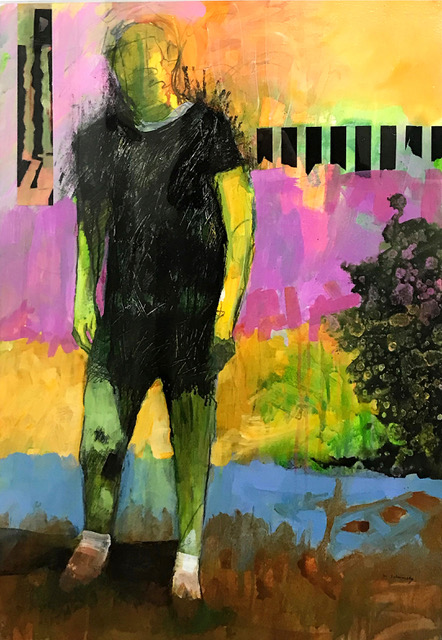For artist Marc Schimsky, a native of Long Island, New York and current resident of Yardley, there’s something intriguing about the brief moments in between actions, the silence in between conversations.
This, said Schimsky, is essentially what his paintings are all about.
“I paint people waiting or gazing or pausing or moving from one place to another,” said the Artists of Yardley member. “A lot can be deduced from the gestures of a figure, from the way people hold themselves, the way that they move, their mannerisms. It fascinates me because a lot is said in between movements. I use the analogy of after a phone call, if you roll your eyes or make a grimace or expression, that sort of tells what you’re really thinking.”
Many times, the individuals featured in Schimsky’s work come from his own mind. But other times, they’re influenced by friends or family. One such painting that was inspired by his father, entitled “The Gardener,” was recently selected by The State Museum of Pennsylvania to appear in its 54th annual “Art of the State” exhibition in Harrisburg.
Schimsky’s submission was chosen out of 2,217 entries from 626 artists. He’ll be among 104 artists spanning 31 counties to have his work on display at the exhibit, which opens to the public on Sunday, Sept. 26, and runs through Jan. 2. A group of awards jurors will determine prize winners, to be announced via social media at noon on opening day. More than $4,000 in cash awards will be distributed.
After receiving the news that he was picked as a finalist for “Art of the State,” Schimsky was very pleased, especially at the fact that a creation so near and dear to his heart was recognized.
“It’s an acrylic on heavyweight paper, 300-pound Farbriano Artistico paper. It was inspired by a photograph that I had found of my father. My parents are originally from Brooklyn, New York. After World War II, my father bought a home in Nassau County on Long Island with the help of the GI Bill, and that’s where I grew up,” reflected Schimsky. “He was kind of a fixer-upper. He enjoyed gardening, pottering around the house. Anytime anything needed to be fixed, he was the one that did it.”

At the time, Schimsky explained how most households didn’t have a clothes dryer. Instead, his father installed a clothesline outside. While he was doing so, someone snapped a photo.
“This photograph of him that I saw just inspired me to do this painting. Of course, you would never be able to tell that it’s my dad. It’s a very unrecognizable face,” he said. “If I paint a figure, I don’t usually paint the features of the face because the moment you do that, then the image becomes highly personal. I would rather that the viewer bring to the painting something from his or her own history. This individual, this image that I create, could be anybody for them. My goal is to create paintings that are challenging and provocative.”
It was in 2005 that Schimsky picked up his brushes for the first time in a while. After earning a degree in printmaking from the Pratt Institute in Brooklyn, New York in 1975, he led a fulfilling career as a high school art teacher. He revisited painting upon retirement.
Currently, his favorite medium to use is paint mixed with cold wax.
“I love this technique because the wax provides a certain luminosity to the image that you can’t get with just straight oils. The way that the light enters the surface of the painting and then bounces back out again creates a certain beauty to the use of the wax,” he said, adding that he often uses a propane torch to adhere layers of color to the surface of the painting. “The way you can achieve flat matte surfaces, as well as raised, glossy surfaces, all within the same painting is very exciting.”
Also enjoyable is the ability to carve into his work of art using tools, including a set of dental instruments recently gifted to Schimsky by a neighbor.
“Being a printmaker, that’s a dream to be able to carve into your painting,” he said.
The arts, whether it was painting, music or theater, always served as an escape for Schimsky. They provided him a sense of solace throughout all the hardships he’s endured.
A week before Schimsky’s 13th birthday, his father passed away. His mother remarried about a year later, and he found his new home environment “intolerable.” Schimsky would escape to the woods as often as he could, where he’d carve images into a block of wood. The next day, he’d bring his creation to school and print the block in the art classroom on imported Japanese rice paper. This was the start of his printmaking passion.
Devastation struck Schimsky’s life yet again when his younger brother died in his early 30s from congestive heart failure caused by drug abuse. He turned to art for comfort. Then, at the age of 1, Schimsky’s son contracted croup. Due to hospital errors, the baby went into cardiac and respiratory arrest. Loss of oxygen caused a year of blindness and paralysis on one side. Art helped Schimsky get through.
In the ‘90s, Schimsky himself developed heart disease and was diagnosed with stage four prostate cancer. He has undergone two bypass surgeries in a two-year period, radiation and hormone therapy.
“Sometimes I stop to remind myself that despite all my health issues, I’m still alive at 71 and I still have my art,” he said. “Out of the darkness, into the light.”
Other good things in life include 50 years of marriage to his wife, and the two sons and five grandchildren they share.
Visit marcschimsky.com and statemuseumpa.org for more information.
Samantha Bambino can be reached at [email protected]


